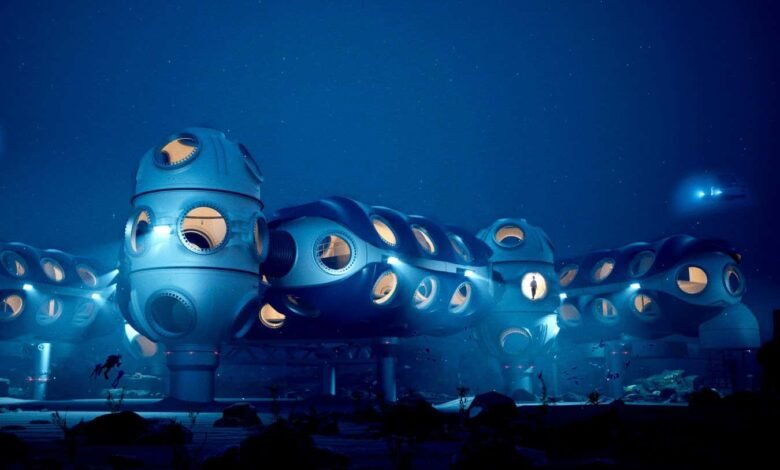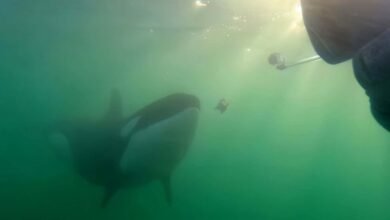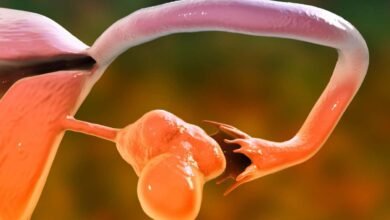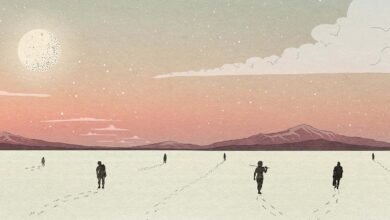Could undersea living be the future as sea levels rise?


Is this the future, in a world where the seas are rising?
DEEP R&D Ltd
The Sama-Bajau are an Indigenous seaborne people from South-East Asia, sometimes called Sea Nomads. For thousands of years they lived a coastal subsistence lifestyle, foraging underwater without diving equipment and holding their breath for extreme durations. But multiple crises threatened their way of life in the early 21st century. Industrial over-fishing, pollution and coral bleaching hit their food supplies, and sea-level rise engulfed their coastal homes.
In 2035, a community of Bajau people living off the coast of Sabah, northern Borneo, raised seed funding to build a modern floating and subsea community. They worked with Deep, a manufacturer of undersea habitats, to build a network of rafts and submarine homes, creating a business model replicated by other maritime communities and populations threatened by sea-level rise. Income streams included opportunities for extreme vacations, scientific research facilities and anti-ageing clinics.
The initial habitat was a series of rafts and platforms with tunnels connecting to subsea levels. People lived in structures on the surface, but, as they got used to it, increasingly used subsea areas for eating and sleeping as well as storage. The habitats were built using a 3D-printing method called wire arc additive manufacturing, which allowed extra strength to be added in regions experiencing the most pressure.
Deeper structures were maintained both at ambient pressure – the pressure of the surrounding water – and at atmospheric pressure equivalent to the surface. In ambient modules below 20 metres deep, aquanauts breathed a specialised mixture of gases to avoid pressure sickness. Anyone leaving a deep module needed to undergo decompression when returning to normal atmospheric pressure. The advantage of ambient modules, however, was they could be fitted with moon doors – pools in the floor opening directly into the ocean. Aquanauts could swim directly out into the deep ocean, for recreation, research and farming activities.
Subsea hotels for extreme tourism became popular. In the Galapagos, tourists could stay at the Hydro-Rift Hotel, over a kilometre deep, and take trips in submersibles to hydrothermal vents, witnessing some of the most unusual lifeforms on the planet. Elsewhere, scientists used modules to study life in the deep. Seabed mapping was made easier and, over the years, researchers explored far more of the ocean than had previously been visited. Great advances were made in understanding and even communicating with whales and other deep-sea organisms.
Aquanauts could swim directly out into the deep ocean, for recreation, research and farming activities
The Bajau were already adapted to marine life. Over thousands of years spent living on and around the sea, they had evolved large spleens, providing them with more oxygen-holding red blood cells than average humans. Some Bajau divers spent up to 5 hours per day underwater, and they were able to free-dive – without using compressed air – to 70 metres deep, holding their breath for up to 15 minutes. Once they moved to subsea habitats, some Bajau renounced the surface, spending most of their time underwater and opting for body modification and even gene editing to enhance their aquatic nature. This included intentional rupturing of the ear drum to improve diving at depth, while deep-diving Bajau used surfactants in their lungs to help them collapse at high pressure, as seen in diving marine mammals.

A Bajau diver
Marko Reimann/Alamy
Some communities offered clinical treatments at depth. Earlier research had indicated that exposure to intermittent daily sessions of breathing pressurised oxygen, known as hyperbaric oxygen therapy, had benefits for a range of medical conditions and age-related diseases. People who had regular hyperbaric sessions had longer telomeres and increased clearance of old (senescent) cells, both factors known to promote longevity. Deep modules became popular with rich older people looking to prolong their lives, and provided a valuable source of income.
Most maritime communities were self-sufficient, producing all the food they needed through aquaculture of fish, molluscs and seaweed, and growing other crops on the surface. Energy was provided by a mixture of solar, wind, wave and hydrothermal power, according to location. Some specialised in tourism, some in medical facilities, some in carbon storage; growing vast amounts of seaweed, sinking it into the abyss and selling the carbon credits.
Sea life wasn’t for all. But the modules empowered people who were most at risk from climate change, and provided ways for them to shape their own careers and lifestyles, even as sea-level rise wiped away their heritage.
Rowan Hooper is New Scientist‘s podcast editor and the author of How to Spend a Trillion Dollars: The 10 global problems we can actually fix. Follow him on Bluesky @rowhoop.bsky.social
Topics:
Source link




